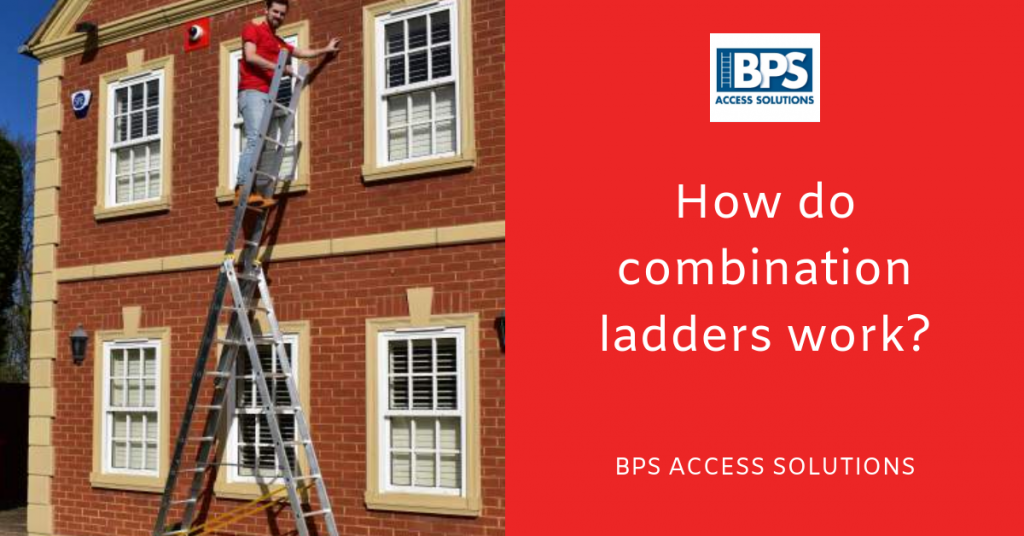How do combination ladders work?
Combination ladders have many points of appeal for homeowners with a variety of different jobs to complete as part of an ongoing project or a long term plan for home renovations or decoration. They are designed with ease of use in mind but can initially seem complicated to the layman. However, nothing could be further from the truth. We will discuss below the main types of combination ladder and their suitability for different jobs for ardent DIYers who have never used them before or homeowners looking to improve their property who could be daunted by what initially seems to be a complex professional piece of equipment.
Firstly, it is worth considering the qualities of combination ladders that set them apart from simpler, more traditional designs. They are particularly useful for working at height that involves uneven or stepped floor surfaces.
Benefits of combination ladders
- Versatility – Combination ladders are designed to allow the user to construct them in a variety of different configurations. This means that one piece of equipment can take the place of multiple ladders. This saves time and effort erecting and removing multiple ladders and makes transporting equipment easier as only one piece is necessary.
- Cost – This is an important consideration for many non professional users. Purchasing a different ladder for each job being performed can be very expensive and the average person will usually have a limited budget. Buying cheaper models is one option but many cheaper models will be made from less durable materials or to inferior designs, making them less safe.
- Storage – Obviously, storing one ladder rather than many is going to preferable to most users. Most homeowners will only have limited space to store equipment and most combination ladders are quite small when collapsed after use. This also makes them easy to transport, even if only a normal car is available.
- Safety – As combination ladders have more points of contact with the floor, they will have increased stability. This reduces the chances of the ladder slipping or falling over and they will not need to be tied off during use, saving time and effort. Some models also come equipped with a stabiliser bar at the base of the ladder which increases the footprint and therefore stability even further
There are five main types of combination ladder we will discuss here, each with different strengths for particular work and each with slightly different styles of deployment. It is worth considering these before choosing the best combination ladder for your needs.
Different models and how they work
- Two section combination ladder – On first inspection, these look like a normal two section extension ladder. The similar construction means they can be used a non self – supporting shorter ladder or a catch is released and the upper section can be extended as normal to form a large extension ladder. However, it is also possible to stand the ladder upright and open it to form a two sided ‘A’ frame stepladder with rungs on both sides. A strong nylon strap on either side prevents over extension so the ladder is at the correct angle and a steel retaining bar can be attached to prevent the sections pushing back together during use. This gives the user a sturdy stepladder and a stabiliser bar can also be attached to the base for added security
- Three section combination ladder – These consist of three sections, similar to a three – section extension ladder. The topmost section can be detached for use as a non self – supporting one – piece ladder or when reattached a catch can released and the top section extended and, if required another catch released on the bottom section and the second section also extended to form a very large extension ladder. The bottom and middle sections can again be opened out to form a self – supporting ‘A’ frame stepladder then secured by straps and retaining bar. When the ladder is erected in this configuration, the stepladder also has an extending section that can be released and extended, then secured with a catch to give an inverted ‘y’ shaped ladder. This allows the user to work at greater heights like an extension ladder with all the added stability of a stepladder.
- Two section stair combination ladder–Again, these have two sections and can be erected as a two section non self – supporting extension ladder or a two – sided stepladder. However, it is also possible to partly extend the top section then open the two sections like a stepladder. The two sections can then be locked into place to give a stepladder configuration with the bottom of each section at different heights so that the ladder can stand securely on staircases. A stabiliser bar at the bottom of the section in contact with the ground gives optimum stability even though the ladder is sited on two different levels. This model is perfect for decorating stairwells as the user can reach around to all angles and the ladder does not to be rested on a surface to be decorated.
- Three section stair combination ladder – These are erected in exactly the same way as the previous model, but when built in the stair ladder configuration the third section can be extended and locked in place to give even further reach when the ladder is sited on two different levels. The increased height and reach make these one of the most comprehensive design of stair ladders for decorating. When extended, the top section should always be at an angle of seventy five degrees to the floor for optimum stability. Again, a stabiliser bar at floor level will help even more. Both stair ladder models are also useful for external work on sloping ground surfaces.
- Three way combi stair ladder – Resembling a small domestic stepladder, these are the perfect lower cost option for most interior decorating and maintenance jobs. One side can be extended to form a short two section extension ladder capable of reaching the top of walls or ceilings in most domestic rooms. If not fully extended, the sections can be tilted away from each other and locked in the same way as the two section stair ladder. This allows the user to set it up on two different levels such as a staircase. These are narrower than other combination ladders, so will be the best option for narrow staircases or other limited spaces. As a result they do not come equipped with a stabiliser bar but have splayed feet with large rubber grips to broaden the footprint and add stability.
At BPS Access Solutions we have a range of combination ladders for sale, including all types discussed above. All our models are manufactured from hardwearing, non corroding Aluminium and are rigorously tested to EN 131 Professional standard. We offer free next day delivery to anywhere in the mainland UK and all our products come with a no quibble lifetime guarantee. If you have any queries, please contact our friendly staff who will be happy to help.
Email : customerservices@bpsaccesssolutions.co.uk
Telephone : 0333 006 9776
No related posts.



